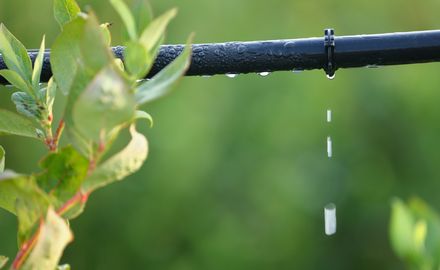Better water management could halve the global food gap

Drip irrigation. Photo: thinkstock
“Smart water use can boost agricultural production – we’ve in fact been surprised to see such sizeable effects at the global level,” says lead-author Jonas Jägermeyr from the Potsdam Institute for Climate Impact Research. In a water management scenario the scientists call ambitious, global kilocalorie production could rise by 40 percent, while according to UN estimates roughly 80 percent would be needed to eradicate hunger by the middle of this century.
But even in less ambitious scenarios, results show that integrated crop water management could make a crucial contribution to filling the plates of the poor, says Jägermeyr. “It turns out that crop water management is a largely underrated approach to reduce undernourishment and increase climate resilience of smallholders.”
+++Large yield increase potential in China, Mexico, Australia+++
The scientists have run comprehensive biophysical computer simulations, constraining these in such a way that croplands do not expand into forests and no additional water resources are needed. As it is a global study, it provides detailed vegetation dynamics and water use effects in river basins – certainly too coarse to simulate farm-level conditions but suited to identify regional hotspots.
For example, the yield increase potential of crop water management is found to be particularly large in water-scarce regions such as in China, Australia, the western US, Mexico, and South Africa.
“Assessing the potential is tricky: If upstream farmers reroute otherwise wasted water to increase irrigation and production, less water returns to downstream users and consequently this can affect their production,” says co-author and team leader Dieter Gerten. “Below the line, we found that the overall production increases. Still, this of course poses quite some distributional challenges. Also, a lot of local government regulation and incentives such as-micro credit schemes are needed to put crop water management into large-scale practice.”
+++Mulching and drip systems to counter climate change impacts+++
The scientists took into account a number of very different concrete water management options, from low-tech solutions for smallholders to the industrial scale. Water harvesting by collecting excess rain run-off for instance in cisterns – for supplementary irrigation during dry spells – is a common traditional approach in some regions such as the Sahel region in Africa, but is under-used in many other semi-arid regions such as Asia and North America. Mulching is another option – the soil gets covered either simply with crop residues left on the field, reducing evaporation, or with huge plastic sheets. Finally, a major contribution to the global potential is upgrading irrigation to drip systems.
It is especially under ongoing climate change that water management becomes increasingly important to reduce food risks. The reason is that global warming is likely to increase droughts and change rainfall patterns, so water availability becomes even more critical than before. Assuming a moderate CO2 fertilization effect – plants take up CO2 and could hence benefit from higher concentrations in the air, but the magnitude of this effect is still under debate –, the study shows that in most climate policy scenarios water management can counterbalance a large part of the regional warming impacts on farming. Yet if greenhouse-gas emissions from burning fossil fuels are not reduced at all, in a business-as-usual scenario, water management will clearly not suffice to outweigh the negative climate effects.
+++Given the planetary boundaries, decision-makers should look into water use+++
”Water management is key for tackling the greater sustainability challenge,” says Wolfgang Lucht, co-author of the study and co-chair of PIK’s research domain Earth System Analysis. “It has been an issue in many local and regional studies and its effects on farm level have been well demonstrated, but on the global level it has been somewhat neglected. The renewed Sustainable Development Goals – while stipulating sustainable agriculture among all nations – need to be based on more evidence on how to achieve it; they do not focus on water use very much. Since we’re rapidly approaching planetary boundaries, our study should indeed draw the attention of decision-makers of all levels to the potential of integrated crop water management.”
Article: Jaegermeyr, J., Gerten, D., Schaphoff, S., Heinke, J., Lucht, W., Rockström, J. (2016): Integrated crop water management might sustainably halve the global food gap. Environmental Research Letters 11, 025002 [doi: 10.1088/1748-9326/11/2/025002]
Weblink to the article once it is published: http://iopscience.iop.org/article/10.1088/1748-9326/11/2/025002
For further information please contact:
PIK press office
Phone: +49 331 288 25 07
E-Mail: press@pik-potsdam.de
Twitter: @PIK_Climate
Media Contact
All latest news from the category: Earth Sciences
Earth Sciences (also referred to as Geosciences), which deals with basic issues surrounding our planet, plays a vital role in the area of energy and raw materials supply.
Earth Sciences comprises subjects such as geology, geography, geological informatics, paleontology, mineralogy, petrography, crystallography, geophysics, geodesy, glaciology, cartography, photogrammetry, meteorology and seismology, early-warning systems, earthquake research and polar research.
Newest articles

Bringing bio-inspired robots to life
Nebraska researcher Eric Markvicka gets NSF CAREER Award to pursue manufacture of novel materials for soft robotics and stretchable electronics. Engineers are increasingly eager to develop robots that mimic the…

Bella moths use poison to attract mates
Scientists are closer to finding out how. Pyrrolizidine alkaloids are as bitter and toxic as they are hard to pronounce. They’re produced by several different types of plants and are…

AI tool creates ‘synthetic’ images of cells
…for enhanced microscopy analysis. Observing individual cells through microscopes can reveal a range of important cell biological phenomena that frequently play a role in human diseases, but the process of…





















